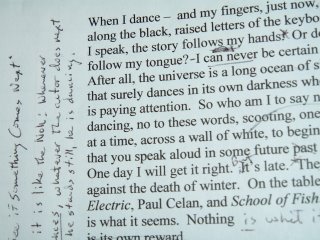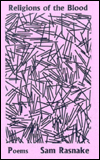deeper into self...
from my anthology of must read (a)merican poems
Larry Levis
Words for the Axe
Each day I go further into the woods.
They fall before me like a road
Without stars, and without a curve.
It goes on the ocean, now.
And at night I fly so deeply into myself
I become still. I shine under the moon
Like the lost child you glimpse
Beneath the ice on the one day of the year
You decide to go skating.
Whoever it is that holds me, my one friend,
Is only a flowing of blood:
And blood spreads like branches in summer,
The leaves shading a house where the people
Sleep, and the birds keep their distance
From other birds, and it is the world.
It is the world— and where the ground was hard,
I helped bury its dead,
Hacking past rocks and roots until
I found a place, even for them.
There is no moral to my story.
From the outset, I gleamed, like a sea.
*
Larry Levis, a master of tone and imagery, writes a poetry that never fails to swallow me whole. His ability to create a detailed scene has few equals. The lines are rich and disturbing – and very real.
In “Words for the Axe,” Levis uses archetypal imagery – the forest, a starless road, the sea, flight, the lost child – creating a perfect setting for epiphany. He is establishing the world of the imagination. Blood, as simile, becomes a tree shading a house where people sleep. I like Levis’ use of the word people – a stand-in for the universal and the unknown. He’s writing about worlds created in and by the mind. Levis repeats, “It is the world,” emphasizing a state of existence with the verb.
Earlier in the poem, the speaker is traveling on a road “without stars, and without a curve,” implying that the destination is uncharted but direct. What remains is instinct. There will be terrors – as illustrated wonderfully by the sight of the lost, dead child. One possible reading of this work would be for the dead child to represent the failed drafts, the poems that never reach paper, that become lost to the writer. Yet, this is a poem with many layers. The child is also that part of the self that must be released. Though the night is starless, the moon causes the speaker to illuminate the landscape – and the lost child is viewed. Levis writes,
And at night, I fly so deeply into myselfThe stillness – what a powerful moment in the poem – is the beginning of the imagination’s creative force.
I become still.
Levis opens the poem with an astonishing line: “Each day I go further into the woods.” Whatever the work of life is, it is new – or should be new – every day. The poem’s strong concluding line shows that we are transported by words: “From the outset, I gleamed, like a sea.” The sea is reflecting the moon – a sign of enlightenment and self-awareness … as well as a powerful image for Ch’an and Zen writing. It’s fragile, but real – it is the world.
As Levis writes … there’s no moral here. Only the hard fact … We don’t learn life by reading about it. A life must be lived. Likewise, one learns poetry by living it, by writing it. “I helped bury its dead” reminds me of William Stafford’s notion that he would trade everything he’d ever written for a new poem. This is life – taking up the axe, making a path.









6 comments:
I find Levis to be an astonishing poet. His collection is, of course, limited by his death. Yet I can still go back to one of his books that perhaps I haven't picked up for awhile and open to a poem that suddenly seems brand new. Last night I started reading Elegies again, a book that isn't his best and isn't his easiest to get into...but is, still, amazing.
Thanks for sharing your thoughts on this poem.
Gorgeous! Thank you, Sam.
Thanks Jim and Suzanne for the read.
Your interpretation of the pieces you read Sam is so insightful and you seem to glean so much from them - i agree with you that this poem is deeply rich with its imagery. A child of his imagination. Thanks>
Thanks for sharing this poem from Levis. This is my first time hearing of him. And thanks for the analysis. I agree there is great imagery in this poem. I enjoyed reading it from beginning to end.
Thanks Natalie and M Shahin for your comments.
Post a Comment